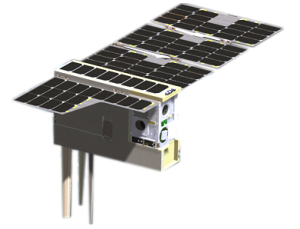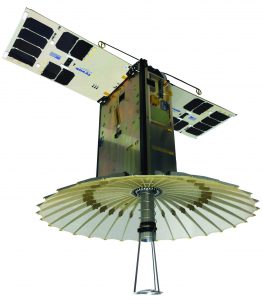2020 Holidays Mark the End for Two CubeSat Missions
01/14/2020 On Thanksgiving and Christmas, two tiny satellites re-entered Earth’s atmosphere after successfully completing their missions.
The two CubeSats – CubeRRT (CubeSat Radio Frequency Interference Radiometer Technology) and RainCube (Radar in a CubeSat) – achieved their objectives to test and validate new technologies to study Earth from space.
They also far exceeded estimates of endurance, stretching months of planned missions into over two years of operations. Both were launched on May 21, 2018, from NASA’s Wallops Flight Facility in Virginia to the International Space Station and were subsequently deployed from the station on July 13, 2018. A period of solar minimum likely contributed to their longevity. During periods of increased solar activity, the sun heats and expands the atmosphere, which increases drag on satellites in low Earth orbit, accelerating their orbital decay.
CubeRRT’s final orbit was detected on Thanksgiving Day, and the final communication from RainCube was received on Christmas Eve.
CubeRRT – Removing Interference in Radiometric Signals

A rendition of the CubeSat CubeRRT.
Led by Joel Johnson at the Ohio State University, the CubeRRT six-unit CubeSat mission demonstrated on-board, real-time Radio Frequency Interference (RFI) processing from space.
Passive microwave observations of Earth have seen an increase in man-made signals over the last few decades, which corrupts geophysical retrievals in a variety of crucial science products, such as soil moisture, atmospheric water vapor, sea surface temperature, sea surface winds, and many others. As RFI sources expand, measurements become more difficult, akin to understanding a whisper at a loud concert. The CubeRRT mission aimed to demonstrate that these artificial signals could be effectively filtered out on board the spacecraft, which would reduce the overall volume of data transmitted to scientists on the ground.
CubeRRT’s radiometer payload included a broadband antenna, a broadband radio frequency front-end unit, and a digital back-end unit that performed the on-board detection, filtering, and mitigation of RFI. Despite an early failure in the radio frequency front-end unit, CubeRRT successfully demonstrated its digital backend, paving the way for new microwave instrumentation and measurement possibilities. CubeRRT’s team is proposing to integrate the technology with several future space-born missions.
In 2020, the team published the latest CubeRRT results in the journal IEEE Xplore and received a patent for its ultra-broadband RF system.
RainCube – Vertical Profiling of Precipitation

A rendition of the CubeSat RainCube,.
The six-unit RainCube CubeSat mission, led by Eva Peral at the Jet Propulsion Laboratory, demonstrated the first radar instrument on a CubeSat and validated a new architecture for Ka-band precipitation radars as well as a new, ultra-compact, deployable antenna.
Climate and weather models rely on inputs from a variety of space-borne measurements, but there are only a few instruments in orbit that observe precipitation. A constellation of RainCubes could provide the temporal resolution – at the scale of minutes rather than hours – needed for future modelling of rapidly-evolving weather phenomena.
Over more than two years of operations, RainCube took scores of precipitation profile measurements, including alongside the GPM (Global Precipitation Measurement) satellite and the TEMPEST-D (Temporal Experiment for Storms and Tropical Systems Demonstration) CubeSat.
The RainCube team also focused on technology improvements: understanding the pulse compression performance of the radar instrument, ground models for processing the on-orbit radar instrument data, and algorithms to more accurately point the satellite.
US patents were issued to two key elements of the RainCube radar payload – the parabolic deployable antenna and the offset IQ modulator. The article, “RainCube: the first ever radar measurements for a CubeSat in space,” received the 2019 SPIE JARS Best Paper for Photo-Optical Instrumentation and Design.